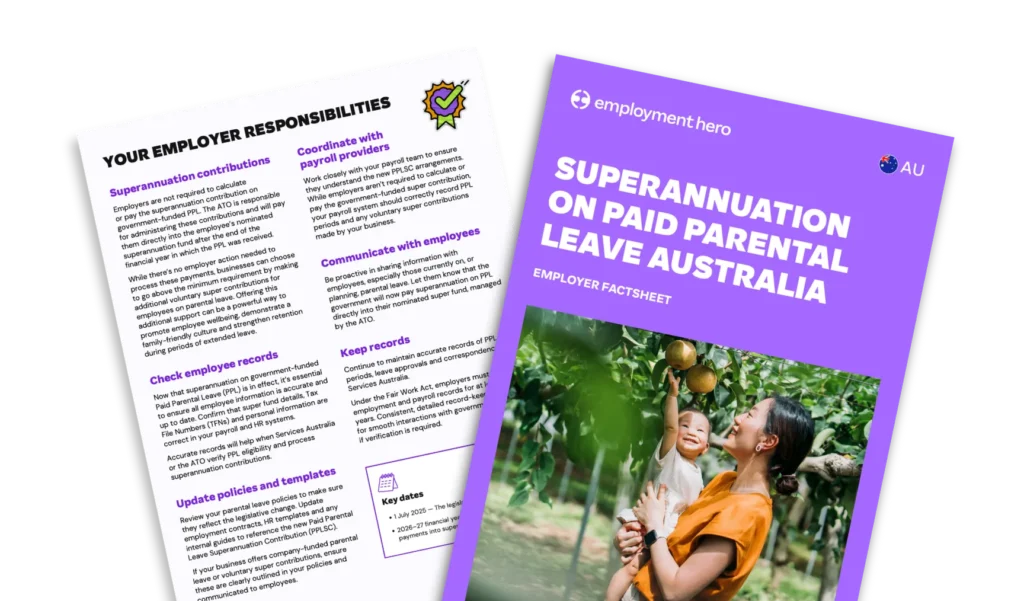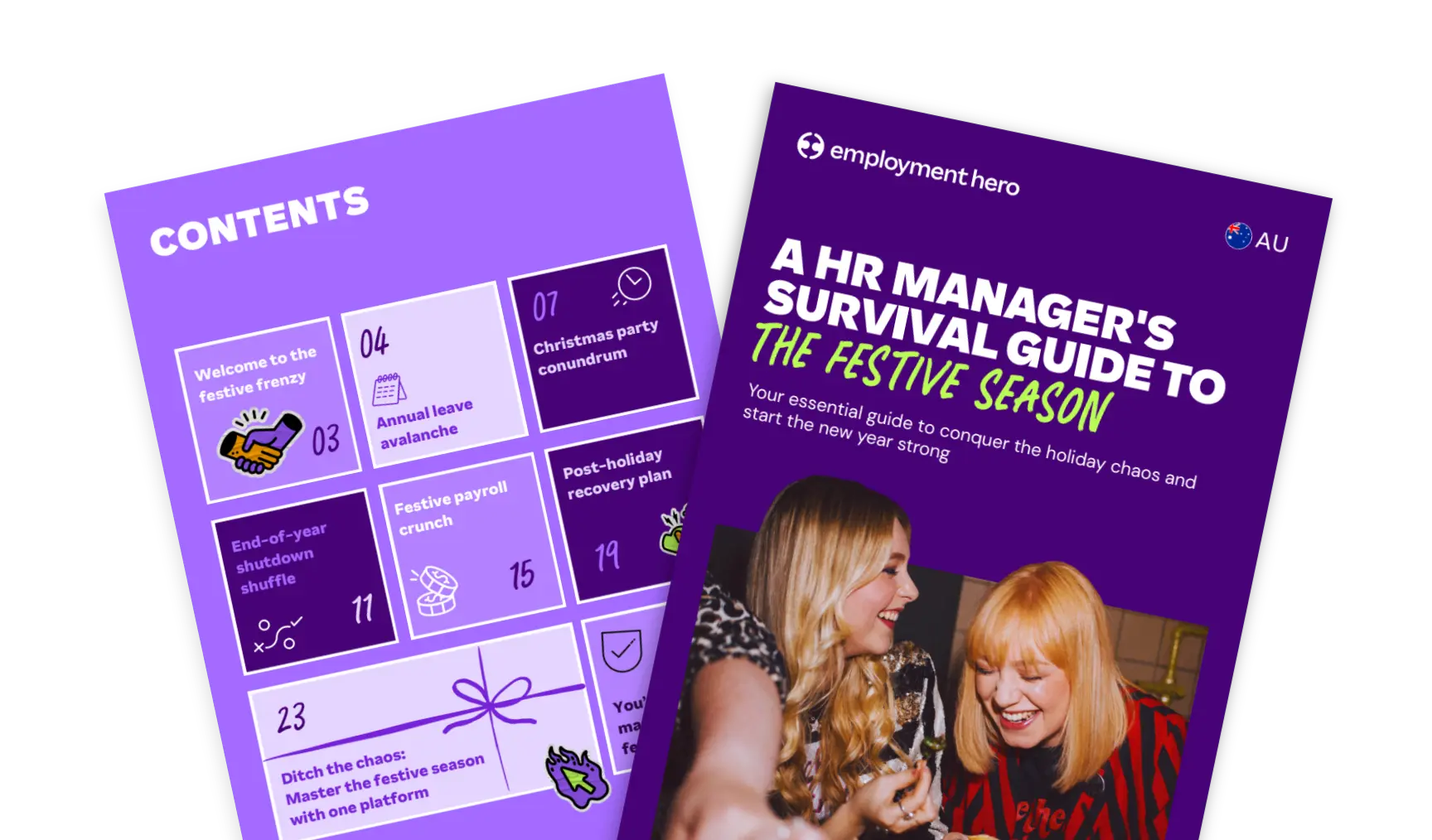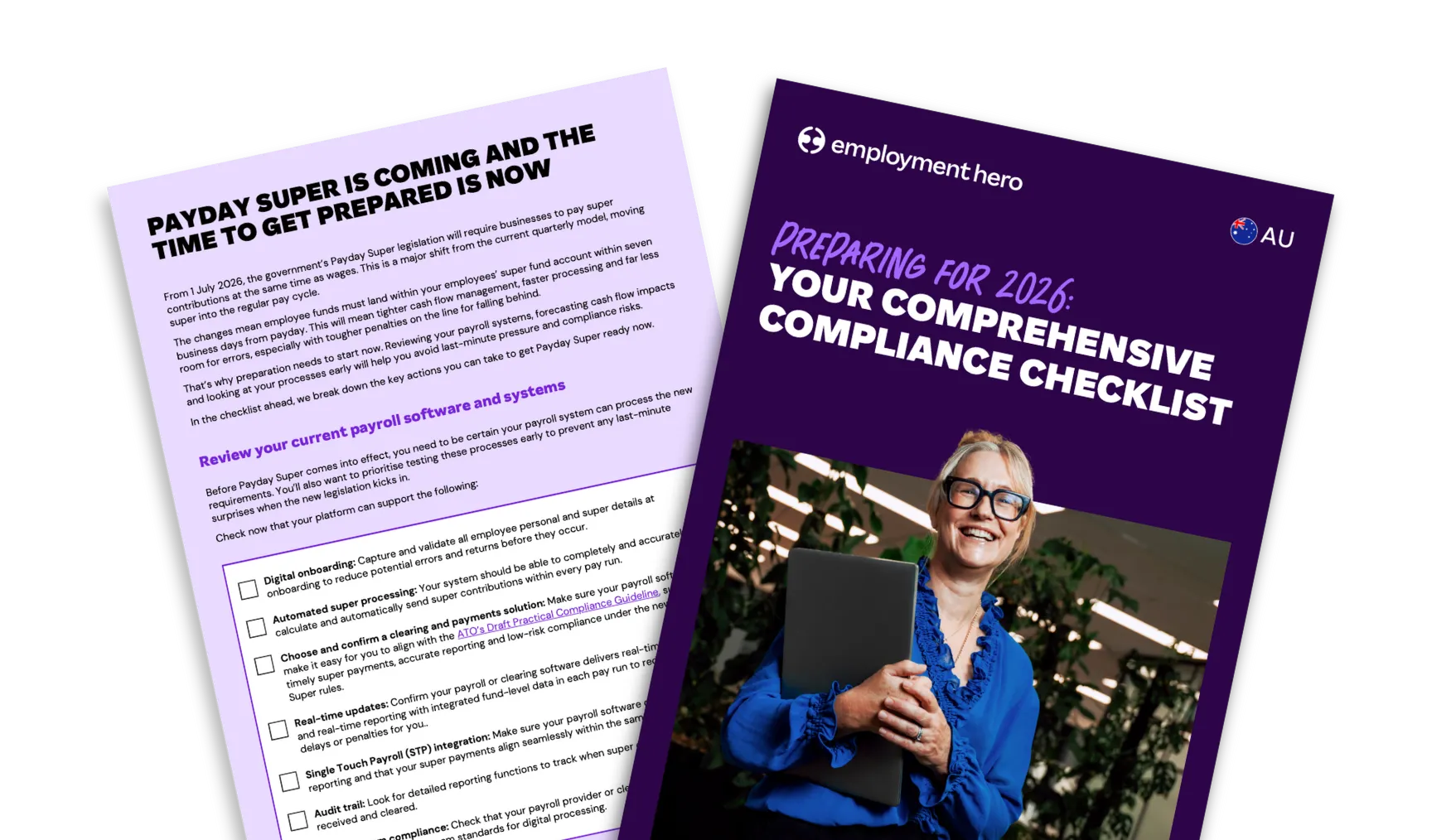Superannuation on paid parental leave: Employer factsheet
Published
Superannuation on paid parental leave: Employer factsheet
Published
Managing parental leave is a key responsibility for any employer. From 1 July 2025, a significant change came into effect, where superannuation is now be paid on government-funded Paid Parental Leave (PPL). This is a huge step forward in supporting working parents, however it also brings new information you need to be across.
We’ll break down exactly what’s changed, who’s eligible and what you need to do.

What’s covered in this factsheet?
Here’s a quick overview of what this factsheet covers:
- A breakdown of the legislative change and who is eligible.
- Clear guidance on employer responsibilities and the ATO’s role.
- Who is eligible for the paid parental leave super contribution.
- How the paid parental leave superannuation contribution works.
Download the superannuation on paid parental leave factsheet now.
What is paid parental leave in Australia?
Australia’s Paid Parental Leave (PPL) scheme is a government-funded program designed to provide financial support to eligible parents of a newborn or recently adopted child. It helps parents take time off work to care for their child.
The Australian Government funds PPL through Services Australia. In most cases, Services Australia pays employers, who then pass the payment on to their eligible employees through their usual payroll process.
However, Services Australia can also pay employees directly, depending on the employee’s circumstances (for example, if they have not been with their employer for 12 months or are no longer employed).
The changes to superannuation on paid parental leave
From 1 July 2025, the Australian Taxation Office (ATO) will pay superannuation contributions on government-funded PPL.
This reform aims to close the superannuation gap experienced by parents, particularly women, who take time out of the workforce to care for their children.
By adding super to PPL, the government aims to create fairer retirement incomes and reduce the long-term financial impact of having a child.
Who is eligible for the paid parental leave super contribution?
Eligibility for the superannuation payment is directly tied to eligibility for the government’s PPL scheme. If an employee is approved for PPL by Services Australia, they will be eligible to receive superannuation on those payments.
To be eligible for PPL, an employee must:
- Be the primary carer of a newborn or newly adopted child.
- Meet residency requirements.
- Have met the PPL work test in the 13 months before the birth or adoption.
- Have an individual adjusted taxable income (ATI) limit of $180,007 or less for the reference income year (which is the financial year before the birth/adoption or the year the claim is lodged, whichever is earlier). If an individual cannot satisfy the individual income test they can still get PPL if they satisfy the family income test which is that they and their partner have a combined adjustable income of $373,094 or less.
Both parents can share parental leave pay, and the superannuation contribution will apply to whichever parent receives the PPL payment.
How the paid parental leave superannuation contribution works
From 1 July 2025, parents of children born or adopted on or after this date will be eligible for a superannuation contribution paid by the Australian Taxation Office (ATO) on their government-funded PPL payments.
The contribution will be calculated at the Superannuation Guarantee (SG) rate and delivered as a lump sum to the employee’s nominated superannuation fund after the end of the financial year in which the PPL was received. Employers are not required to calculate or pay this contribution themselves, although they may make voluntary contributions if they wish.
What you need to do to prepare for PPL super contributions
From 1 July 2025, parents of children born or adopted on or after this date who receive government-funded parental leave pay will become eligible for a superannuation contribution (the PPLSC) based on the Superannuation Guarantee rate.
The contribution will be paid by the Australian Taxation Office (ATO) directly into the employee’s superannuation fund in a lump sum after the relevant financial year ends (with the first payments expected in the 2026-27 financial year).
Employers are not required to calculate or pay this contribution, but should ensure their systems and records are ready for this legislative change.

Expansion of the paid parental leave scheme
Alongside the introduction of super, the PPL scheme itself is expanding. The government is progressively increasing the number of weeks available, with the total reaching 26 weeks by July 2026.
This expansion is designed to give families more flexibility and encourage parents to share parental leave pay. As an employer, this means you may manage PPL payments for longer periods and for a more diverse range of family structures.
Download our comprehensive guide on parental leave.
Information for employers about PPL super payments
Clear communication is vital when new changes come into effect. Your employees will have questions about this new entitlement and how it affects their financial security.
Here’s how you can support your team:
- Inform your team: Let employees know about the change, explaining that super will now be paid on PPL from 1 July 2025.
- Update policies: Review and update your internal parental leave policies to reflect this new workplace entitlement.
- Act as a resource for your team: Direct employees to official sources like Services Australia or the ATO for personal advice, but be prepared to answer questions about how your business will handle the payments.
For a deeper dive into payroll management, download our Payroll Guide to learn more.
Download the superannuation on paid parental leave factsheet now.
Disclaimer: The information in this factsheet is current as at 1 November 2025, and has been prepared by Employment Hero Pty Ltd (ABN 11 160 047 709) and its related bodies corporate (Employment Hero). The views expressed in this factsheet are general information only, are provided in good faith to assist employers and their employees, and should not be relied on as professional advice. The Information is based on data supplied by third parties. While such data is believed to be accurate, it has not been independently verified and no warranties are given that it is complete, accurate, up to date or fit for the purpose for which it is required. Employment Hero does not accept responsibility for any inaccuracy in such data and is not liable for any loss or damages arising either directly or indirectly as a result of reliance on, use of or inability to use any information provided in this factsheet. You should undertake your own research and seek professional advice before making any decisions or relying on the information in this factsheet.
Register for the factsheet
Related Resources
-
 Read more: HR Managers: Don’t just survive the festive season, master it
Read more: HR Managers: Don’t just survive the festive season, master itHR Managers: Don’t just survive the festive season, master it
Make year-end easier: manage leave, payroll, parties and shutdowns with confidence. Get practical tips for Australian SMEs. Download the free…
-
 Read more: Preparing for 2026: Your Compliance Checklist
Read more: Preparing for 2026: Your Compliance ChecklistPreparing for 2026: Your Compliance Checklist
Get your business ready for the 1 July 2026 changes. See practical steps for Payday Super, cash flow planning and…
-
 Read more: Monthly business budget template for employers
Read more: Monthly business budget template for employersMonthly business budget template for employers
Plan your monthly income and expenses with our free monthly business budget template. Download today to track cash flow and…























